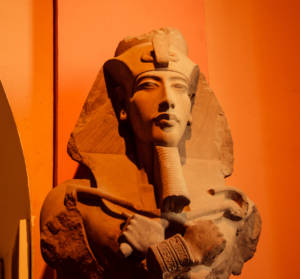Monotheism in Ancient Egypt: The Story of Akhenaten

While most people associate monotheism with the three Abrahamic religions, the concept of a single, all powerful god was also promulgated in ancient Egypt.
Monotheism has long been associated with Abrahamic religions. The first verse of the Shema, the most significant prayer in Judaism, states: “Hear O’ Israel, the Lord is our God, the Lord is One.” The Islamic concept of Tawhid holds that God is singular and indivisible. In Christianity, the Trinity doctrine asserts that God is a singular entity with three persons. While these are our most familiar examples of monotheism, it isn’t limited to Abrahamic faiths. One of the most drastic shifts from polytheism to monotheism happened in a place you may not expect: ancient Egypt.
Atum: Father of the Gods
Thousands of years ago, Kemetic polytheism was the norm in Egypt. The Ancient History Encyclopedia describes ma’at, the essential balance that governed the universe according to the Kemetic worldview. Atum, the chief deity, once existed alone on a great hill standing in the primordial swirl of chaotic nothingness. From him came humanity as well as the progenitors of Kemet’s primary gods. Osiris, Isis, Set, and Nephthys were Atum’s great-grandchildren. He had scores of other descendants, including Horus, Anubis, Bastet, and Hathor.
Religious and Political Divisions
Kemet’s unification in 3150 B.C.E. started nearly 3,000 years of dynastic rule. Yet the northern and southern regions didn’t always coexist harmoniously. Each had a distinctive religious subculture, according to ancient history professor James K. Hoffmeier: The sun god Ra was preeminent in the northern Delta region, while the south venerated Amun.
Kemet’s civil war started in 2150 B.C.E and lasted about 150 years. Each region had its own pharaoh, with Memphis as the north’s seat of power and Thebes as the south’s capital. Mentuhotep II, a Theban monarch, ended the war by defeating the northern rulers and reunifying the north and south. Amenemhet I, who founded Kemet’s Twelfth Dynasty, combined the north’s and south’s chief gods into a single deity: Amun-Ra.
A Sun God’s Royal Devotee
Amun was the chief deity during the first part of the New Kingdom period starting in 1570 B.C.E. Historian Joshua J. Mark mentions that Amun’s depictions combined the most essential attributes of both Atum and Ra, resulting in a god that encompassed every aspect of creation. Amun’s cult was extremely popular, to the point where ancient Kemetic religion embodied monotheism.
Amenhotep IV, who came to power in 1353 B.C.E, would change all of that. About five years later, he abandoned his worship of Atum and became a devotee of Aten. He enacted sweeping religious reforms, instituting a monotheism with Aten as its deity. He erased other deities’ names from public monuments, ordered Amun’s priests to serve the new god, and sent his palace guards to destroy relics, idols, and texts devoted to Amun. Another Encyclopedia Britannica piece reveals that other gods suffered the same fate: Even Amun’s chief consort Mut and the word “gods” were removed from temples all over the land.
Amenhotep IV also changed his name to Akhenaten. Just for context, the name translates as “beneficial for Aten.” He dedicated several new temples to Aten, complete with iconography depicting the Aten sun disk shining its rays upon the royal family. In another Ancient History Encyclopedia article, Joshua J. Mark mentions that Akhenaten declared himself the living incarnation of Aten and his wife Nefertiti to be a god.
Uncertain Motives and a Complicated Legacy
What motivated Akhenaten to make such extreme changes? Political self-interest is one possibility: He could steal power and influence away from the Amun priesthood. Hoffmeier speculates that Akhenaten may have also experienced what he believed was a divine manifestation. Either way, his work was undone after he died. His son King Tut changed his name from Tutankhaten to Tutankhamun, and Aten’s temples were later dismantled. Yet the records left behind show a fascinating yet troubling pattern that would be repeated in other cultures throughout human history.

